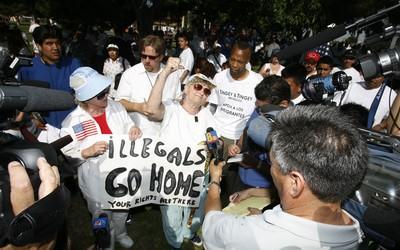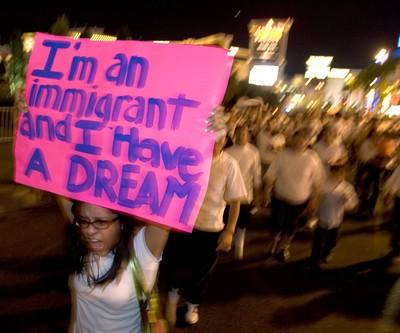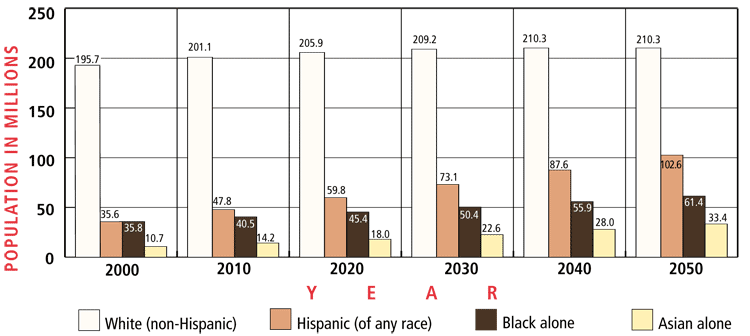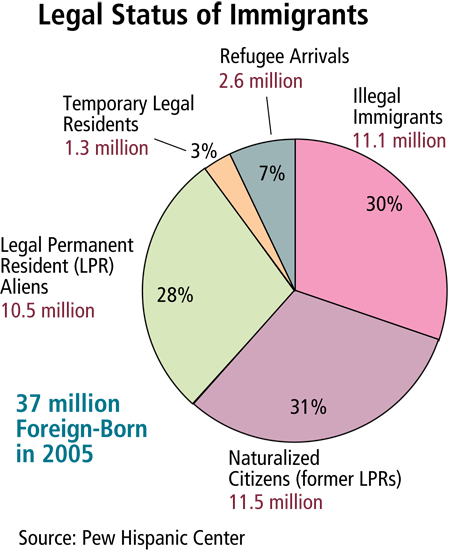BOOMTOWN RUSH





Between 6 percent and 10 percent of Clark County residents are here illegally, about double the percentage of illegal immigrants nationwide.
Yes, most illegal immigrants work cheaply, so they may help keep down the price of a new house or a restaurant meal. But how do they affect the community’s tab for public education or emergency health care? No one has comprehensively measured the public costs or benefits associated with illegal immigrants in Nevada. So the many heated opinions on what to do with them, or for them, lack a factual basis.
It’s hard to precisely count people who, by definition, are trying to hide. But illegal immigrants — noncitizens who reside in this country without permission and, if discovered, can be deported for their lack of legal status — are making a mark on the Silver State by sheer volume. In contrast to Clark County, the nation’s percentage of illegal immigrants is only 3.5 percent of total population, based on 2005 data from federal census and immigration reports.
Mexico is the top source of illegal immigrants nationwide, 57 percent of all illegal immigrants, as measured in 2005 by the U.S. Department of Homeland Security. Coincidentally or not, signs of Hispanic influx abound in Southern Nevada.
Spanish-speaking lawyers, taxmen, radio stations, even funeral homes are hyped, in Spanish, on Las Vegas billboards.
The third most common name for boys born in Nevada in 2006 — "Angel," according to the Social Security Administration — is popular among Hispanics.
Public sidewalks near plant nurseries are a morning hangout for day laborers, who chat in Spanish as they wait for jobs.
And Pahrump, a bedroom community 60 miles from Las Vegas, raised hackles in the past year by passing, and then repealing, an ordinance designed to stem illegal immigration, in part by declaring English the town’s official language.
But a Las Vegan’s Hispanic appearance or Spanish accent can reveal only ethnicity or culture, not legal status. The person speaking Spanish in public may well be a native-born or naturalized citizen.
In an expanding economy such as the one in Las Vegas, population growth is usually good for employers, who are ravenous for workers.
"Las Vegas is an immigrant town. It’s always been an immigrant town," asserts Jerry Stuchiner, a local immigration attorney who moved to Las Vegas in 1997 after 21 years as a federal immigration officer.
"We’re very keen to acknowledge the fact (that) much of our industry and our hotel has been built with an immigrant work force," said Lisa Ward, director of employee training at Bellagio. For years, her department has held naturalization workshops to help its eligible foreign-born workers become citizens.
Down the road there is a "demographic dividend" to absorbing Hispanic immigrants today, according to California sociologist Ruben Rumbaut. Their comparative youth "slows and offsets" the nation’s overall aging trend.
There’s also a cost to not absorbing them, points out Sylvia Lazos, a UNLV law professor. Assimilated immigrants have upward mobility, which increases the nation’s productivity and tax revenues. Alienated immigrants have downward mobility, which can exhibit in the form of Hispanic teens joining gangs or bearing illegitimate children.
A lot rides on how Congress handles the mammoth hot potato still in its lap: comprehensive immigration reform. One bill just died in the Senate. The longer Congress dithers, the more U.S.-citizen children will be born to illegal immigrants, which complicates the original problem.
WHY NEVADA?
Nevada places 10th when states are ranked, high to low, by the estimated size of their illegal populations, according to 2005 data from the Department of Homeland Security. And yet, Nevada ranks only 35th when the U.S. Census lists states by total population.
The Silver State’s concentration of illegal immigrants is surprising, considering the state doesn’t lie on a national border or on a coast. It is not an entry point for foreigners, except those who arrive by air.
It is, however, gripped as if by a pair of pliers, between the border states of Arizona and California. And more new Nevadans come from California than any other state, a trend that isn’t confined to ex-Californians who are citizens or legal permanent residents. As of January 2005, California was home for 26 percent of all illegal immigrants in the United States, according to the Department of Homeland Security.
Another likely reason for Nevada’s high concentration is that Southern Nevada is a powerful job magnet. Its two big industries, hospitality and construction, make good use of hard workers with little education, a description that fits many illegal immigrants.
The vast majority of new Las Vegans are citizens moving here from other states. But when a foreign influx is noticeable, it injects an ethnic tinge to the volatile debate on the costs of growth in Clark County.
Mexico is the top source of illegal immigrants in the United States, but they still come from around the globe. The non-Latin nations of India, China, Korea and the Philippines also made Homeland Security’s 2005 list of the top 10 nations producing illegal U.S. immigration.
Likely reasons for Mexico’s dominance are its proximity, its troubled economy and U.S. immigration enforcement strategy. Strategy is geared to making southern border arrests, so statistics of Mexicans caught while crossing are high. But the strategy doesn’t help count illegal immigrants who reach the nation’s interior undetected. Some immigration analysts say statistics are unreasonably low for Canadians or other visitors who overstay the terms of their visits, which makes them illegal immigrants, too.
HOW MANY ARE THERE?
Numbers of illegal immigrants are elusive, whether the context is Nevada or the nation. Here are two recent stabs at taking their count in the Silver State:
• 150,000 illegal immigrants in Nevada, reported the Center for Business & Economic Research at UNLV in June 2006. Of that total, an estimated 120,262 live in Clark County, which is the state’s most densely populated area. That’s presuming illegal residents spread out in the same proportion as foreign-born residents (a category that the U.S. Census does track), with about 80 percent in Clark County and 20 percent distributed through the rest of the state.
• 240,000 illegal immigrants in Nevada, the Department for Homeland Security calculated, in a 2005 report from its Office of Immigration Statistics.
Making for dramatic demographic tilt, the illegal immigrant influx into Nevada is happening swiftly. Illegal immigrants to Nevada increased by 41 percent between 2000 and 2005, according to Homeland Security. The only states with higher percentage increases for the period were Georgia (114 percent) and Arizona (45 percent).
Jobs in carpet mills attract illegal immigrants to Georgia, explains UNLV’s Lazos, whose research interest is the law as a tool in race relations. Likewise, beef-packing plants draw them to Iowa, and poultry plants to southern Missouri, where Lazos used to teach. "Illegal immigrants are incredibly efficient at settling in places where there is demand for their services," she explains.
Suggesting anti-immigration backlash in Nevada, Las Vegans vastly overestimated the presence of illegal immigrants in a 2006 opinion poll conducted by the nonprofit Pew Hispanic Center.
Illegal immigrants account for only 30 percent of the U.S. foreign-born population, but 54 percent of Las Vegans interviewed said "most immigrants" are in this country illegally. Nationally, 44 percent of respondents said "most" were here illegally.
ILLEGAL IMMIGRANTS ARE YOUNG
People who foresee a good future in their country of origin are less inclined to start over as illegal immigrants in a new country. They tend to have limited prospects at home, and be young enough to relocate.
"I always heard about this country. It provoked me to come," said Las Vegan Cesar Perez, 37, who arrived in California more than two decades ago as a 15-year-old illegal immigrant from Mexico. He has been a legal permanent resident since 1988, and a Las Vegas hotel worker since 1996.
The willingness to take risks for a better future explains the national profile of illegal immigrants published by the Pew Center in June 2005. More than half, 59 percent, are here alone or have no children at all, because of their youth. But almost all illegal immigrant adult males work (94 percent, compared to 83 percent of native-born U.S. males) while only 54 percent of the women work outside the home (compared to 72 percent of native-born females).
Illegal immigrants usually have low education levels, earn comparatively low incomes and often lack health insurance, according to Pew. It’s not clear if their higher school dropout rate is from pressure on teens to take jobs to help the family, or because of a language problem, low grades or disenchantment. No profile of illegal immigrants in Nevada is available.
HOW MUCH DO THEY COST?
Several states have tried to determine the financial impact of illegal immigrants, with mixed findings. Nevada has not done such a study, nor has it commissioned another party to do so.
In Colorado, this group cost more than it contributed, according to a study by the Bell Policy Center that came out in June 2006. The center concluded that illegal immigrants there paid, in state and local taxes, an amount equal to 70 percent to 86 percent of the costs they generated for compulsory education (kindergarten through 12th grade), emergency health care and jail-prison services.
A Texas study released in late 2006 countered the Colorado experience, perhaps because Texas does not have a state income tax, while Colorado does. In states like Nevada and Texas, which depend mainly on user fees and consumption taxes — such as the property tax, sales tax and gasoline tax — all residents pay their way, including those here illegally. Nevada or Texas revenues are not affected if workers are paid under the table, a common practice in many fields where illegal workers are concentrated, although that scenario does reduce federal revenue.
"Undocumented immigrants in Texas generate more taxes and other revenue than the state spends on them," according to the report prepared by the Texas comptroller. Their tax contributions exceeded their state costs by $424.7 million in 2005. But Texas hospitals and local governments spent more on illegal immigrants than they took in from them, the report noted.
"When people say the undocumented cost a lot more, they’re not really looking at all the ‘kitties’ that people put money into," UNLV’s Lazos notes. "One of the things we don’t see at the local level is the billions of dollars in Social Security" that illegal immigrants are "donating" via their paychecks. She is referring to the subset who supply fake or misappropriated Social Security numbers to get a paycheck, and will never get retirement credit for those payroll contributions.
Pay now or pay later?
School districts in particular are experiencing financial stress as a result of immigration, both legal and illegal. Because of their youth, many illegal immigrants are in their childbearing years. They tend to have families larger than native-born citizen households, the Pew Hispanic Center reports. But, so do legal immigrants.
The average native-born family size was 1.96 people, Pew reported in 2005, versus 2.65 for the average family containing an illegal immigrant. Legalized immigrants have families that are even larger, on average: 2.66 people per household.
"You go to K-through-12 systems anywhere in the country — you go to Iowa, southern Missouri, Georgia — when you go into a classroom, it’s Latino kids who are becoming the key cohort," which means the predominant ethnic group in that age group, Lazos explains. In fall 2006, the Clark County School District reached an ethnic tipping point. For the first time, its enrollment demographics turned it into a "majority minority" district, in which Hispanic students outnumber non-Hispanic white students.
For support, just play out these numbers from the nonprofit Population Reference Bureau, which looked at U.S. vital statistics from 2000 to 2004. For every Hispanic death, there were 8.2 births. Among non-Hispanic whites, though, only 1.2 births occurred for every death.
That sort of "replacement rate," if prolonged for years, means two things.
First, it indeed means the browning of the United States. The "browning" term denotes the phenomenon of Hispanics becoming a larger share of the U.S. population. The causes are Hispanic immigration, legal and illegal, plus Hispanic birth rates. Even if an immigrant is illegal, his or her Children are U.S. citizens if born here.
The replacement rate complicates the immigration debate in Southern Nevada, as well as in the nation as a whole. Are non-Hispanics truly upset about illegal immigration, or is the core of their dismay the growing number of Hispanics who have legal status to live here?
The present numerical bulge of children in immigrant Hispanic families creates a "front-loaded" financial burden for strapped school districts, and for public hospitals that struggle to give emergency care to uninsured illegal immigrants or their children, who, according to Pew, are mostly citizens but nonetheless poor.
But second, as sociologist Rumbaut readily points out, the present bulge of immigrant Hispanic youth also means that if, today, taxpayers bite the bullet to fully educate kids in immigrant families — despite their special needs, such as English instruction — tomorrow they will be optimally productive adults helping to float social programs, such as Medicare or Social Security, for all Americans.
ILLEGAL IMMIGRATION: Counting The CostMore News StoriesView the illegal immigrant population by state SOME TERMS ARE WIDELY MISUSED AND CARRY EMOTIONAL BAGGAGE Before drawing conclusions on what Nevada’s immigrant numbers mean, it’s wise to agree on terminology. Immigration law is larded with jargon. Some terms refer to precise groups of people, but are widely misused in casual conversation. Not everyone in the United States who is foreign-born is a foreigner: that is, a non-citizen. A naturalized U.S. citizen — who may speak English poorly, with an accent — is a person who has gone through official channels to become a citizen. Alien is a term used by the Department of Homeland Security, which houses most immigration functions, to denote a person in the United States who is not a U.S. citizen. A legal permanent resident is an alien who has lawful permanent residency; the document to prove this status is often called a green card. A deportable alien, also called an illegal alien, is a person who entered the United States either by fraud or without an inspection at a conventional U.S. customs checkpoint. Or, an illegal alien can also be a foreigner who entered the country with legal status, as a visitor, for example, but then overstayed the limits of his or her visa. A fugitive alien is an alien who has received a final deportation order, but is still in the country by avoiding the authorities. Such a person can also be called an "immigration fugitive" or "alien absconder." Illegal immigrant is the preferred term called for by the Associated Press Stylebook, which is used by the Review-Journal. Despite government usage of the terms, they also carry emotional baggage. "Illegal alien" is offensive to some, including David Thronson, a professor at the Boyd School of Law at UNLV who co-directs the school’s immigration-law clinic. He prefers other terms, such as "unauthorized immigrant" or "undocumented immigrant." When a foreign official visits, such as Britain’s prime minister, "we don’t say, ‘Alien addresses Congress,’" Thronson says, to demonstrate that "alien" is usually reserved for negative talk about noncitizens. JOAN WHITELY/REVIEW-JOURNAL FAILED FEDERAL PROPOSAL A controversial immigration reform bill sought to give legal status to an estimated 12 million illegal immigrants currently in the United States. The bill called for increased security along the U.S.-Mexico border in the form of thousands of additional agents and 370 miles of fencing. Illegal immigrants who came to the country before Jan. 1 of this year could get renewable visas to live and work legally after paying a fine and passing a background check. Other key provisions of the failed bill: • A temporary worker program to fill jobs that U.S. citizens and other legal Americans are not doing. • A real-time verification system to allow employers to determine the legal status of employees. • An employment-based point system to determine the education and skill level of potential immigrants seeking green cards. STATE ACTIONS State lawmakers tried to put their mark on the immigration debate during the recently completed legislative session in Carson City. The Nevada Legislature passed a bill allowing the state Tax Commission under certain circumstances to levy fines against companies that hire illegal immigrants. A provision allowing the state to revoke licenses of companies that hire illegal workers was removed from the bill. A bill to declare English the official language of Nevada failed. So too did a legislative attempt to deny Millennium Scholarships and state loans to illegal immigrants attending state schools and universities. The initiatives reflect frustration among state and local legislators across the country with how the federal government has dealt with immigration issues, said Mark Krikorian, executive director of the Center for Immigration Studies.












